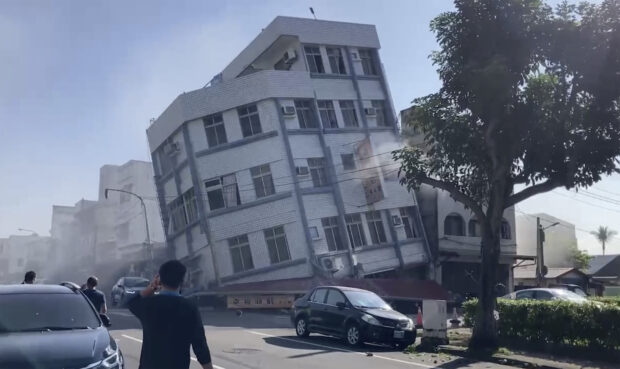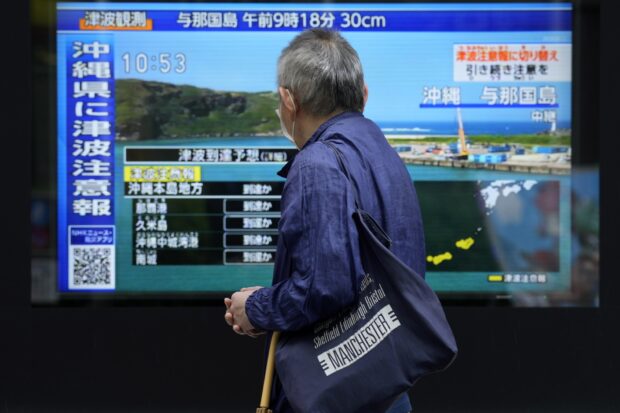Tsunami alert in 4 northern Luzon provinces lifted – Phivolcs

In this image taken from a video footage run by TVBS, a partially collapsed building is seen in Hualien, eastern Taiwan, on Wednesday, April 3, 2024. A powerful earthquake rocked the entire island of Taiwan early Wednesday, collapsing buildings in a city and creating a tsunami that washed ashore on Japanese islands. (TVBS via AP)
MANILA, Philippines — The Philippine Institute of Volcanology and Seismology (Phivolcs) has now canceled the tsunami warning it earlier raised in four provinces of northern Luzon following the 7.4-magnitude quake near Taiwan.
In its 10:33 a.m. advisory, Phivolcs said it did not observe any serious sea level tremors since the earthquake struck waters off Taiwan at 7:58 a.m. on Wednesday, April 3.
“With this, any effects due to the tsunami warning have largely passed, and therefore, DOST-PHIVOLCS has now canceled all Tsunami Warnings issued for this event,” Phivolcs said.

READ: Tsunami alert up in parts of PH after magnitude 7.5 quake hit near Taiwan
“This will be the final tsunami information issued for this event,” it added.
Following the powerful earthquake near Taiwan, a tsunami alert was raised over the Batanes Group of Islands, Cagayan, Ilocos Norte, and Isabela, urging residents to evacuate to higher ground immediately.
Phivolcs also said in its initial forecast that the first tsunami waves might arrive on Wednesday between 8:33 a.m. and 10:33 a.m. The tsunami waves did not take place, it added.
Taiwan’s strongest earthquake in a quarter century rocked the island during the morning rush on Wednesday, damaging buildings and creating a tsunami that washed ashore on southern Japanese islands. No immediate reports of deaths or injuries were reported, and the tsunami threat largely passed about two hours later.
A five-story building in the lightly populated southeastern coastal city of Hualien near the epicenter appeared heavily damaged, collapsing its first floor and leaving the rest leaning at a 45-degree angle.
In the capital, tiles fell from older buildings and within some newer office complexes, while debris fell from some building sites. Schools evacuated their students to sports fields, equipping them with yellow safety helmets. Some also covered themselves with textbooks to guard against falling objects as the aftershocks continued.
Train service was suspended across the island of 23 million people, as was subway service in Taipei, where a newly constructed above-ground line partially separated. The national legislature, a converted school built before World War II, also had damage to walls and ceilings.
Traffic along the east coast was at a virtual standstill, with landslides and falling debris hitting tunnels and highways in the mountainous region. Those caused damage to vehicles, though it wasn’t clear if anyone was hurt.

A person stands along a sidewalk to watch a TV showing breaking news on the tsunami for the Okinawa region on Wednesday, April 3, 2024, in Tokyo. Japan issued tsunami alerts on Wednesday after strong quakes near Taiwan. (AP Photo/Eugene Hoshiko)
Despite the quake striking at the height of the morning rush hour, just before 8 a.m., the initial panic faded quickly on the island that is regularly rocked by earthquakes and prepares for them with drills at schools and notices issued via public media and mobile phones.
Still, the earthquake was strong enough to scare people who were used to such shaking.
“Earthquakes are a common occurrence, and I’ve grown accustomed to them. But today was the first time I was scared to tears by an earthquake,” Taipei resident Hsien-hsuen Keng said. ”I was awakened by the earthquake. I had never felt such intense shaking before.”
She said her fifth-floor apartment shook so hard that “apart from earthquake drills in elementary school, this was the first time I had experienced such a situation.”
There was still no word on casualties from the epicenter near the city of Hualien, where a deadly quake in 2018 collapsed a historic hotel and other buildings. Taiwan’s worst quake in recent years struck on Sept. 21, 1999, with a magnitude of 7.7, causing 2,400 deaths, injuring around 100,000 and destroying thousands of buildings.
The Japan Meteorological Agency said a tsunami wave of 30 centimeters (about 1 feet) was detected on the coast of Yonaguni Island about 15 minutes after the quake struck. Smaller waves were measured on the Ishigaki and Miyako islands. Japan sent military aircraft to gather information about the impact on the Okinawa region.
Taiwan’s earthquake monitoring agency gave it a magnitude of 7.2, while the United States Geological Survey (USGS) put it at 7.4. It struck about 18 kilometers south-southwest of Hualien and was about 35 kilometers (21 miles) deep.
Multiple aftershocks followed, and the USGS said one of the subsequent quakes was 6.5-magnitude and 11.8 kilometers (7 miles) deep. Shallower quakes tend to cause more surface damage.
The earthquake was felt in Shanghai and several provinces along China’s southeastern coast, according to Chinese media. China and Taiwan are about 160 kilometers (100 miles) apart. China issued no tsunami warnings for the Chinese mainland.
Residents of China’s Fujian province reported violent shaking, according to Jimu News, an online outlet. One man told Jimu that the shaking awakened him and lasted about a minute. With reports from Associated Press